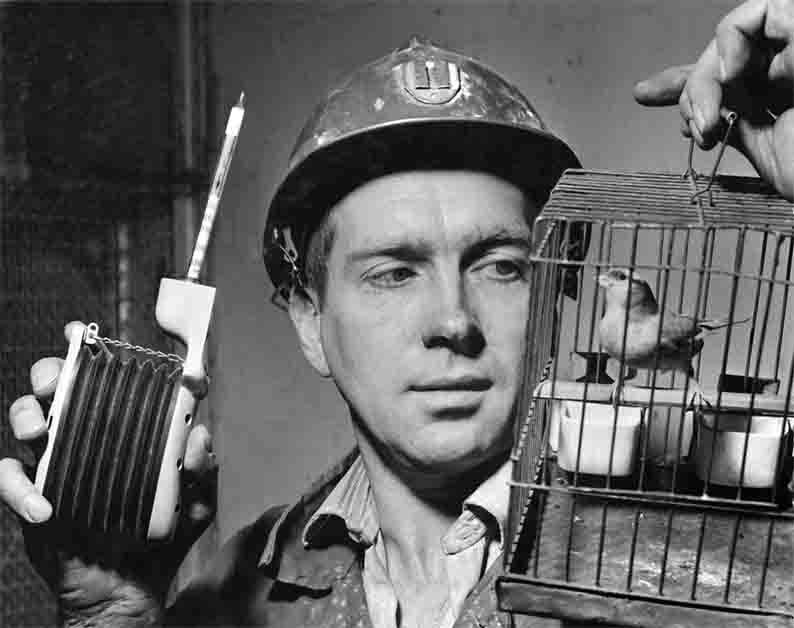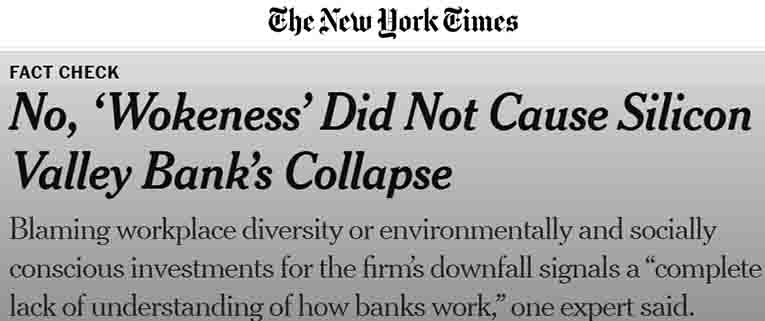
Humour me, why don’t you? Which of the two images below serves best as metaphor for this week’s panic in the markets?


I’d say both but what do I know? Let’s just give praise to the Lord for “fact checkers”. Where would we be without the New York Times to set our minds at rest that political correctness gone mad did not, after all, sink SVB?

Phew – that’s a weight off my mind! Now to business. The short answer to why SVB failed is that it had bought heavily into bonds, when values were high and interest rates miniscule, to cover its interest payments to depositors. Now interest rates are soaring – for the why of that I’ll shortly hand over to savvier heads than mine – so bond values have fallen. They had to, to make their yields attractive to new buyers who’d otherwise opt for those higher interest rates.
(Bonds have fixed rates of interest. The only way to offset these becoming uncompetitive is to lower bond value, and so increase the ratio of interest to asset price.)
Many savings and loan banks can ride out such crises – assuming bond values sooner or later rally – due to saver inertia. Not SVB. Its depositors are wealthy and financially savvy. The lucre they stash is hot money, restlessly flowing in and out of accounts (and continents) in its never ending search for higher returns. For you and me, a point or two of difference – were we even to notice – is unlikely to repay the effort of all that monitoring and switching.
Not so your typical SVB depositor. She wanted her money out, forcing SVB to dump bonds at fire-sale prices. We couldn’t call this a bank run – being driven not by self-fuelling panic but by rational calculation – but the upshot was the same. The dumped bonds couldn’t raise the funds to meet its skyrocketing obligations and the bank went tits-up.
This, I repeat, is the short answer. The savvier heads I’m handing over to are looking beyond that. I start with Michael Hudson. Writing on March 16 in CounterPunch, he begins:
Why the bank crisis isn’t over
The crashes of Silvergate, Silicon Valley Bank, Signature Bank and the related bank insolvencies are much more serious than the 2008-09 crash. The problem at that time was crooked banks making bad mortgage loans. Debtors were unable to pay and were defaulting, and it turned out that the real estate that they had pledged as collateral was fraudulently overvalued, “mark-to-fantasy” junk mortgages made by false valuations of the property’s actual market price and the borrower’s income. Banks sold these loans to institutional buyers such as pension funds, German savings banks and other gullible buyers who had drunk Alan Greenspan’s neoliberal Kool Aid, believing that banks would not cheat them.
Silicon Valley Bank (SVB) investments had no such default risk. The Treasury always can pay, simply by printing money, and the prime long-term mortgages whose packages SVP bought also were solvent. The problem is the financial system itself, or rather, the corner into which the post-Obama Fed has painted the banking system. It cannot escape from its 13 years of Quantitative Easing without reversing the asset-price inflation and causing bonds, stocks and real estate to lower their market value.
In a nutshell, solving the illiquidity crisis of 2009 that saved the banks from losing money (at the cost of burdening the economy with enormous debts), paved away for the deeply systemic illiquidity crisis that is just now becoming clear. I cannot resist that I pointed out its basic dynamics in 2007 (Harpers) and in my 2015 book Killing the Host.
Accounting fictions vs. market reality
No risks of loan default existed for the investments in government securities or packaged long-term mortgages that SVB and other banks have bought. The problem is that the market valuation of these mortgages has fallen as a result of interest rates being jacked up. The interest yield on bonds and mortgages bought a few years ago is much lower than is available on new mortgages and new Treasury notes and bonds. When interest rates rise, these “old securities” fall in price so as to bring their yield to new buyers in line with the Fed’s rising interest rates.
A market valuation problem is not a fraud problem this time around.
The public has just discovered that the statistical picture that banks report about their assets and liabilities does not reflect market reality. Bank accountants are allowed to price their assets at “book value” based on the price that was paid to acquire them – without regard for what these investments are worth today. During the 14-year boom in prices for bonds, stocks and real estate this undervalued the actual gain that banks had made as the Fed lowered interest rates to inflate asset prices. But this Quantitative Easing (QE) ended in 2022 when the Fed began to tighten interest rates in order to slow down wage gains.
When interest rates rise and bond prices fall, stock prices tend to follow. But banks don’t have to mark down the market price of their assets to reflect this decline if they simply hold on to their bonds or packaged mortgages. They only have to reveal the loss in market value if depositors on balance withdraw their money and the bank actually has to sell these assets to raise the cash to pay their depositors.
That is what happened at Silicon Valley Bank. In fact, it has been a problem for the entire U.S. banking system …
Read Professor Hudson in full (2000 words) …
There are differences between Michael Hudson, who is a modern monetary theory sympathiser (though to so confine a political economist of his stature would be crass) and Michael Roberts (an MMT sceptic). Both are of the Left, however, and their points of agreement outweigh their differences, though the one does not render the other redundant. I say give both a read.
Mr Roberts, writing on March 15, begins:
Moral hazard or creative destruction?
As I write, US regional banks stock and bond prices are diving. And a major international Swiss bank, Credit Suisse, is close to bankruptcy. A financial crisis not seen since the global financial crash of 2008 appears to be unfolding. What will be the response of the monetary and financial authorities?
Back in 1928, the then US treasury secretary and banker Andrew Mellon pushed for higher interest rates in order to control inflation and credit fuelled stock market speculation. At his bequest, the Federal Reserve Board began raising interest rates and in August 1929 the Fed banged up the rate to a new high. Just two months later in October 1929, the New York Stock Exchange suffered the worst crash in its history in what was called “Black Tuesday“. History repeats.
In 1929 Mellon was undeterred. He advised the then president Hoover to “liquidate labor, liquidate stocks, liquidate farmers, liquidate real estate… it will purge the rottenness out of the system. High costs of living and high living will come down. People will work harder, live a more moral life. Values will be adjusted, and enterprising people will pick up from less competent people.” Additionally, he advocated the weeding out of “weak” banks as a harsh but necessary prerequisite to the recovery of the banking system. This “weeding out” would be accomplished through refusing to lend cash to banks (taking loans and other investments as collateral) and by refusing to put more cash in circulation. The Great Depression of the 1930s followed a major banking crash.
In 2008, when the global financial crash unfolded, at first the authorities aimed at something similar. They allowed investment bank Bear Stearns to go under. But then came another, Lehman Bros. The Federal Reserve dithered and finally decided not to save it with a bailout of credit. What followed was an almighty crash in stocks and other financial assets and a deep recession, the Great Recession. Fed chair Ben Bernanke at the time was supposedly a scholar of the Great Depression of the 1930s and yet he agreed for the bank to fail. Subsequently, he recognized that as ‘lender of last resort, the job of the Fed was to avoid such collapses, particularly for those banks that are ‘too big to fail’ which would only spread the busts across the whole financial system.
It’s clear that now governments and monetary authorities want to avoid ‘liquidate, liquidate’ and the Lehmans crash, even if such a policy would clear away the ‘dead wood’ and “rotteness of the system” for a new day. Politically, it would be disastrous for governments presiding over yet another banking collapse; and economically, it would probably trigger a new and deep slump. So it’s better to ‘print more money’ to bail out the banks’ depositors and bond holders and avert financial contagion – the banking system being so interconnected.
That’s what the authorities eventually did in 2008-9 and that it what they will do this time too. Officials were initially unsure about rescuing Silicon Valley Bank. They quickly changed their minds after signs of nascent bank runs across the US. Interviews with officials involved or close to the discussions paint a picture of a frenzied 72 hours. Credit Suisse too is likely to get similar financial support.
There are supporters of Mellon’s approach today and they still have a point. Ken Griffin, founder of a large hedge fund Citadel, told the Financial Times that the US government should not have intervened to protect all SVB depositors. He went on: “The US is supposed to be a capitalist economy, and that’s breaking down before our eyes…There’s been a loss of financial discipline with the government bailing out depositors in full.” Griffin added. We can’t have “moral hazard,” he said. “Losses to depositors would have been immaterial, and it would have driven home the point that risk management is essential.”
Moral hazard is when banks and companies reckon they can always get money or credit from somewhere including the government. So if they make reckless speculations that go wrong, it does not matter. They will get bailed out. As Mellon might have put it: it’s immoral.
The other side of the argument is that banks that get into trouble should not mean that those who deposit their cash with them should not lose it through no fault of their own. Governments must intervene to save the depositors. And they too have a point. As another hedge fund billionaire, Bill Ackman, put it when the SVB collapse emerged, the Federal Deposit Insurance Corporation must “explicitly guarantee all deposits now” because “our economy will not function nor our community and regional banking system”. Mark Cuban expressed frustration with the FDIC insurance cap that guarantees up to $250,000 in a bank account as being “too low”; he also insisted the Federal Reserve buy up all of SVB’s assets and liabilities. Rep. Eric Swalwell, a California Democrat, joined the chorus, tweeting that “We must make sure all deposits exceeding the FDIC $250k limit are honored.”
The irony here is that those demanding bailouts now are the very venture capitalists who usually stand firmly for the ‘free market and no government intervention’. Another bailout supporter is one Sacks, a longtime associate of investor Peter Thiel, who fervently believes in ‘free markets’ and in ‘capitalism’. But it was Thiel’s Founders Fund that helped kick off the bank run that sank SVB in the first place …
Read Michael Roberts in full (1500 words) …
My final offering is by Satyajit Das, economics pundit and former banker. It appeared on Naked Capitalism, a blogsite I’ve come to regard as indispensable both for its intelligent coverage of economics – its host Yves Smith (a pseudonym) is an astute economic analyst – and of the Ukraine War. The Das piece featured on March 14. Instead of opening with his own words, as I did with the two Michaels, I’ll let Yves do the introducing:
Yves here. Even with the business press awash with post mortems of the collapse of Silicon Valley Bank (SBV) and editorial comment about the de facto extension of a deposit guarantee to formerly uninsured depositors (the combo of changes in discount window terms and the one-year facility get you there), some key facts are still not getting enough attention. Satyajit Das underscores quite a few in his broad-reaching but compact article below.
One is that SVB had a very high ratio of uninsured deposits to insured deposits. Small deposits are considered good because they are “sticky”. Big deposits are hot money. Banks with a lot of hot money should be conservative and mindful of liquidity risk. SVB clearly was not.
Second is that SVB had several other fairly easy measures it could have taken to considerably mitigate the mess it was in with having so much long-dated bond exposure. Das cites rumors that one of those routes may have been blocked by competitors.
A related third point is why didn’t SVB get out of the way of Fed tightening? The central bank knows it whacks banks. It has therefore taken to telegraph its intentions well in advance so they can get out of harm’s way. Why did SVB remain dug in on a highly exposed strategy?
Finally, as Das delineates, the contagion effects go well beyond US banks.
I hope you’ll read Das’ piece carefully.
Me too. Here’s where to read it (1500 words) …
* * *

Remembering how bad it was in the GFC and looking at the far left (2008/09) and the far right (2022) on that first graph in Hudson’s article the most appropriate words would seem to be those uttered by Captain Blackadder:
“It rhymes with clucking bell!”
The item in question:
Random thoughts from a non-economist.
Why did SVB not take any one of a range of actions that would have prevented their collapse or at least protected them sufficiently to keep operating? Cui bono?
A friend who knows far more about this stuff than me said that immediately prior to the collapse about 200 people were messaged by phone to take their money out. Usually if someone has inside info about such things they quietly withdraw their money and certainly don’t draw attention to the approaching potential crash. So why actively encourage this?
Possibilities.
1: To send a warning to the governments making new banking regulations that the banks have a power to cause trouble unless the lawmakers are very careful and do what the banks want.
2: Nefarious activities deep in the banking system to do with power battles between them.
3: Deep state intervention and subterfuge by the US government to radically alter the international banking system connected with China holding trillions of dollars of US debt.
4: China reminding the US of its nuclear economic power in response to Aukus, threats around Taiwan and other nefarious activities by the American industrial military complex, which now includes NATO, Australia and many other nations.
5: Russian attempts to destabilise capitalism while Russia itself is rapidly becoming self sufficient in energy, technology and food.
6: An intervention by extra terrestrials to put Earth in rehab and save us all.
Take your pick.
More mundane answers to this question are offered in my recent post, Richard Murphy on Silicon Valley Bank. In a nutshell, (a) these ‘masters of the universe’ aren’t nearly as bright as they think they are, and (b) moral hazard of the drearily familiar “tails we win, heads we get bailed out” kind.
I’m not an uncritical admirer of Professor Murphy, another MMT-er. Often tunnel visioned, he can exemplify the Gell-Mann Amnesia Effect. But within his niche he can be spot on. Though it’s short, he finds room in his piece – as does Michael Hudson in his – to show the mix of stupidity and class warfare being waged by the Fed in its use of interest rates.
It’s a cocktail equally favoured in Whitehall and on Threadneedle Street.
Thanks Phil and all the erudite folk who understand more of these things than I do. I am getting an education here. And about what a shit storm it all is.
You and me both Anne